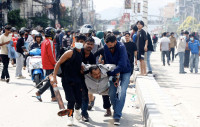Opinion
On mature reflection
What is clearly missing from community schools is incentives to the management system and teachers
Labisha Uprety
Shree Namsaling Higher Secondary School, established in 2006BS, is a sizeable community school located in Namsaling, Ilam. It has close to 45 ropanis of land but fewer than 350 students. The place is scenic—misty and cool in the mornings.
A colleague and I were studying a number of private and community schools in the area. The vice principal of the school was kind and welcoming, and answered all my questions patiently. The teachers were, by and large, genuinely interested in teaching the children. The school-ground, where children played happily, was big enough to take long walks on. But one look at the school’s SLC results, and everything else would seem trivial. The 10th graders in particular were performing dismally, especially in Maths, English and Science. Although I believe that SLC results are hardly the best indicator of a child’s performance, exam results are an important means to assess student progress.
School politics
However, what began as an assessment of exam results led to an eventual examination of the power structure between the school management committee (SMC) and the institution. Every school has an SMC, which is largely comprised of parents of those studying in the school. But there is also space for ‘donors’, which is usually used by political parties to step formally into the school. The principal of the school is also part of the SMC; so is one teacher elected from the pool of teachers.
In a very strange turn of events, none of the community schools we visited had an active principal; all were managed by the vice-principal. One was reportedly away on informal visits, and two had mysteriously failed to turn up at the schools when the audit season came. The money that each community school gets—a sum divided under numerous headings such as salaries and scholarships—requires only the principal’s and the head of the SMC’s signature for mobilisation. It then requires no further monitoring throughout the school year and is examined by auditors at the end of the school year, again handled usually by the principal alone. The audit reports list repair and infrastructure costs. But the teachers state that even classrooms have been without doors for a long time.
We have been more than aware that problems in public schools stem from management practices and the infiltration of politics in them. Private schools are hardly all virtuous, but they deliver better exam results and are generally not an active political breeding ground. One thing missing from community schools is the effective incentivising of the management system and teachers. This is not to say that all private schools practise this. But public schools could begin with incentivising the management system to educate children better rather than pocketing the change with every other transaction.
Hire and fire policy
Teachers in public schools may be better trained than those in private schools, but what good is the training when teacher absenteeism is rife? In particular, those teaching Maths, Science and English seem to continually drop out of public schools and opt for entering the bureaucracy formally, leading to dismal results in these subjects.
A performance-based salary incentive for the contribution—in terms of time, effort and output—for both the SMC members and teachers would perhaps make for a better model, while also allowing for timely checks on monetary transactions. Though the law has provisions for school inspections, this is a rarity in rural areas, where school representatives frankly said that they had never seen a school inspector during their long service at the school.
Gommunity schools rank fairly low in terms of exam results, but it would be premature to conclude that they have all failed. There are many examples of how certain public schools have managed to draw students. These schools hire private teachers to fill in teaching gaps and charge students—usually only those who are directly taught by the private teachers—a small fee to pay them. The flexibility to hire and fire staff is important in an education system that should be retaining only the best teachers. Of course, this does not mean people can be fired without due reason and process; it simply means that the mechanism should be in place and practised when the need arises.
Uprety is a research and communications officer at Samriddhi Foundation, a think tank based in Kathmandu




 14.12°C Kathmandu
14.12°C Kathmandu










